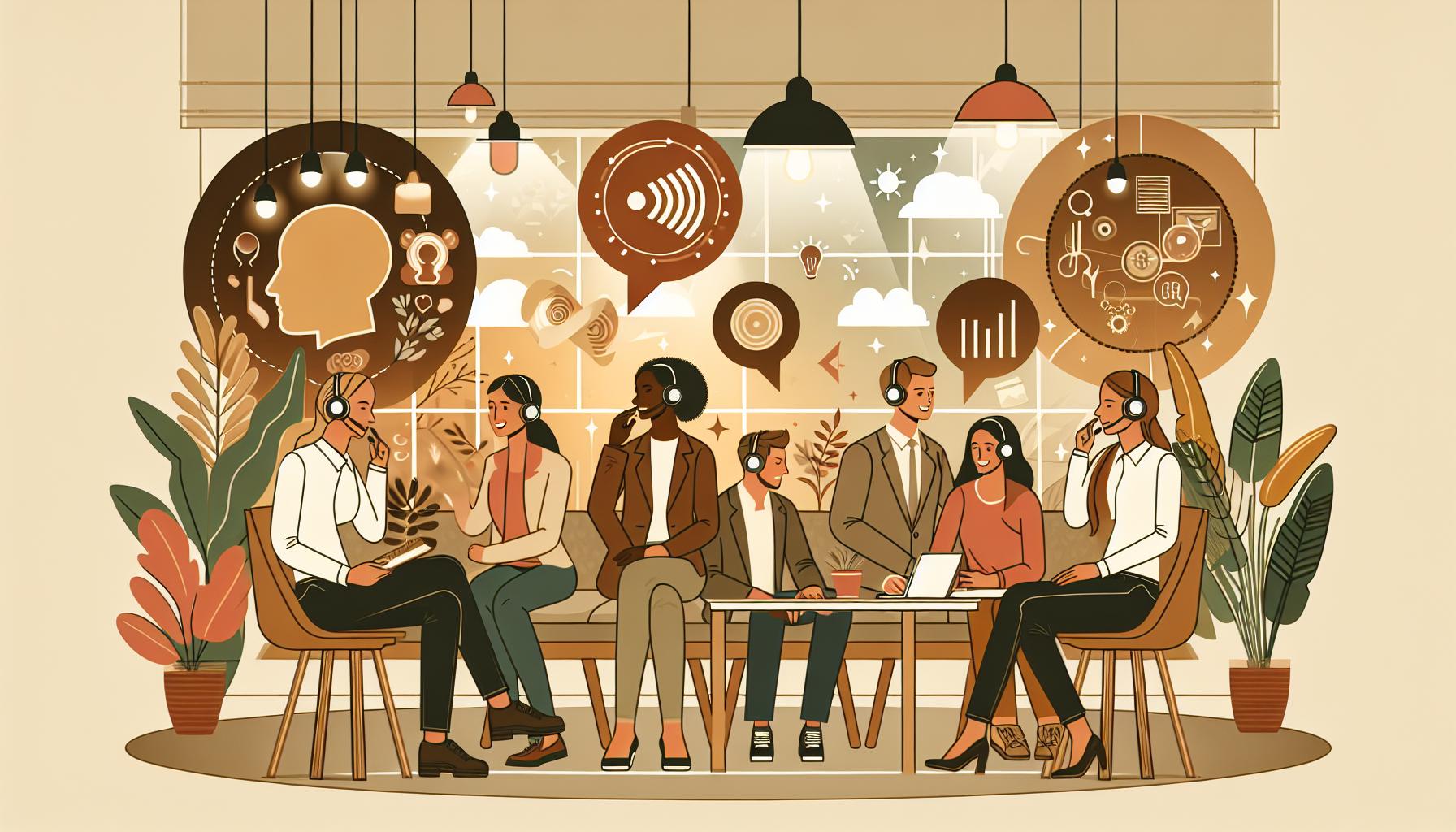In our fast-paced world, genuine communication often takes a backseat, leaving many feeling unheard and disconnected. Active listening is a powerful skill that transforms how we engage with others, fostering empathy and understanding. By honing these seven key active listening skills, you can become a more empathetic communicator, bridging gaps that often lead to misunderstanding and conflict.
Imagine having conversations where both parties feel valued and understood-this is the essence of active listening. Whether you’re a parent working to connect with your child, a professional seeking to build stronger relationships with colleagues, or simply wanting to nurture deeper friendships, mastering these skills will empower you to create meaningful interactions.
As you delve into this article, prepare to explore practical techniques and real-world examples that will enhance your listening abilities. Embrace the opportunity to grow and discover how becoming an active listener can significantly impact your relationships and overall communication success.
Understanding Active Listening: A Fundamental Skill
Active listening is more than just hearing words; it’s a crucial skill that can transform conversations and relationships. Engaging in active listening requires a conscious effort to absorb and understand the speaker’s message, both verbal and non-verbal. This practice fosters deeper connections, promotes empathy, and enhances communication overall. By focusing on the speaker’s words, tone, and body language, listeners can provide more meaningful responses, demonstrating genuine interest and support.
To develop effective active listening skills, one can follow a few foundational steps. First, maintain eye contact to convey attentiveness. Next, practice summarizing or paraphrasing what the speaker has said-this shows that you are engaged and seeking to understand their perspective. Additionally, open-ended questions can encourage the speaker to elaborate, creating a richer dialogue. Embracing pauses during conversations allows for reflection, which can lead to more thoughtful interactions.
Active listening also involves cultivating an empathetic mindset. Recognizing the emotional states of others can guide how you respond and interact. For example, if someone shares a challenge, reflecting back their feelings can validate their experience and foster a supportive atmosphere. Building this skill set not only enhances your personal connections but also positively impacts professional environments, where understanding team members’ perspectives can lead to collaborative problem-solving.
Lastly, integrating mindfulness practices into daily interactions can significantly elevate your listening abilities. Taking a moment to breathe deeply before responding can ground your focus, allowing you to be fully present in the conversation. By making a deliberate effort to practice these techniques regularly, you will notice a marked improvement in your ability to listen actively, connect with others, and develop compassion in your communications.
The Importance of Empathy in Communication
Empathy stands as a cornerstone of effective communication, transforming ordinary exchanges into meaningful connections. When individuals engage empathetically, they not only hear the words being spoken but also tune into the emotions and intentions behind those words. This deeper understanding fosters trust and openness, creating a safe space for dialogue. In professional settings, empathy can enhance teamwork, leading to improved collaboration and problem-solving. For example, a manager who listens empathically to their team members can identify potential issues early on and leverage diverse perspectives to forge stronger solutions.
To cultivate empathy in communication, consider employing the following techniques:
- Practice Reflective Listening: When someone speaks, mirror back their feelings and thoughts to show understanding. Phrases like, “It sounds like you’re feeling frustrated because…” can validate their experiences.
- Ask Open-ended Questions: Encourage sharing by asking questions that invite elaboration, such as, “Can you tell me more about what led to this situation?” This approach not only displays interest but also deepens the conversation.
- Identify Non-Verbal Cues: Pay attention to body language, tone, and facial expressions, which can provide insights into unspoken emotions. A nod or a facial expression of concern can go a long way in conveying empathy.
Integrating these practices into your daily interactions can significantly enhance your ability to connect with others. For instance, during a conflict resolution scenario, approaching discussions with empathy can shift the focus from blame to understanding, resulting in more constructive outcomes. As you develop your empathetic communication skills, you’ll find that relationships, both personal and professional, become richer and more fulfilling. Aim to weave empathy into every conversation, and watch as it transforms not only your interactions but also fosters an environment where everyone feels heard and valued.
Key Components of Active Listening Skills
Active listening is more than just hearing the words spoken; it involves actively engaging with the speaker to ensure mutual understanding and connection. A vital component of this skill is attention, which requires consciously focusing on the speaker without distractions, both mentally and physically. For instance, putting away your phone and maintaining eye contact can signal to the speaker that they have your undivided attention. This practice encourages a more robust dialogue and fosters an environment where the speaker feels valued.
Another key element is feedback, which serves to clarify and confirm your understanding of the message. This can be accomplished through verbal affirmations, such as saying “I see” or “That makes sense,” as well as through non-verbal cues like nodding. Additionally, summarizing or paraphrasing what the speaker has said can demonstrate that you are not only listening but also processing the information effectively. For example, you might say, “So, what you’re saying is that you felt overlooked during the meeting, correct?” This not only validates the speaker’s feelings but also involves them in the conversation.
Empathy plays a crucial role in active listening, as it allows you to connect with the speaker on a deeper emotional level. By attempting to understand their perspective and feelings, you can respond more thoughtfully. A practical approach involves recognizing non-verbal signals, such as tone and facial expressions, which can provide deeper insight into the emotions behind their words. Using phrases like, “It sounds like you are worried about the upcoming project deadline,” can help build rapport and show that you genuinely care about their concerns.
Incorporating the key components of active listening-attention, feedback, and empathy-into your conversations can transform how you communicate. By fostering these skills, you will not only enhance your interactions but also build stronger relationships, paving the way for more meaningful and productive dialogues.
Techniques to Improve Your Listening Abilities
Improving your listening abilities can transform your interactions, allowing for deeper connections and more productive conversations. One effective technique is to practice focused attention. This involves consciously setting aside distractions and centering your mind on the speaker. You might try a simple exercise: during a conversation, take a deep breath and remind yourself to be present. This cultivates a mental environment where you can absorb the entirety of what is being communicated, rather than simply waiting for your turn to speak.
Using reflective listening is another powerful method to enhance your listening skills. This involves paraphrasing the speaker’s message to confirm understanding. For example, after someone shares their thoughts, you might respond with, “What I hear you saying is…” This not only clarifies your interpretation but also shows the speaker that you value their input. Moreover, encouraging questions during this process can deepen the dialogue. Questions such as, “Can you tell me more about that?” or “What do you think led to this situation?” promote further discussion and demonstrate genuine interest.
A significant barrier to effective listening is getting distracted by our own thoughts or forming conclusions before truly understanding the other person’s viewpoint. To combat this, consider adopting mindfulness techniques. These practices can enhance your ability to stay engaged and presented during conversations. Mindfulness exercises, such as meditation or focused breathing, can help alleviate the urge to preemptively judge or analyze, making space for authentic listening.
Incorporating these strategies into daily interactions will build your confidence as a listener. By intentionally applying focused attention, reflective listening, and mindfulness, you’ll foster a greater connection with others. Regular practice not only enhances your interactions but also creates a more empathetic communication style that can lead to improved relationships in both personal and professional settings.
How to Encourage Open Dialogue with Active Listening
Creating an environment that fosters open dialogue is vital for effective communication, and mastering active listening is key to achieving this. When you truly listen to others, you not only validate their feelings but also invite them to share their thoughts and emotions more freely. One powerful way to promote this openness is by practicing empathetic responses. Instead of jumping to solutions or judgments, validate the speaker’s feelings first. Statements like, “It sounds like you’re feeling overwhelmed” can encourage them to elaborate without fear of interruption or dismissal.
Using open-ended questions is another effective strategy. These questions invite deeper conversations and discourage one-word responses. For instance, instead of asking, “Did you like the presentation?” try, “What aspects of the presentation stood out to you?” This approach demonstrates your genuine interest in their perspective, creating a welcoming atmosphere for sharing. Additionally, remember to maintain a friendly and approachable demeanor. Non-verbal cues, such as nodding, maintaining eye contact, and mirroring the speaker’s tone, can significantly enhance their sense of being heard and understood.
It’s essential to create a space where individuals feel safe to express themselves, especially in professional settings. To reinforce this, you might establish ground rules for discussions, such as encouraging respect for differing opinions and promoting confidentiality. This encourages participants to feel secure in sharing their thoughts without judgment. Moreover, reflecting on the feedback received after discussions can further improve the open dialogue process. Consider asking participants what they found helpful or what made them feel comfortable, and be receptive to their suggestions for future conversations.
Finally, using active listening techniques like summarizing and clarifying can foster even more open dialogue. After someone shares their thoughts, paraphrase their message and ask if you’ve captured it accurately. This not only ensures a mutual understanding but also signals to the speaker that their perspective is valued and heard, leading to richer and more productive conversations.
Common Barriers to Effective Listening and How to Overcome Them
Effective listening can often be stymied by various barriers that hinder our ability to connect with others. Recognizing these obstacles is an essential step towards becoming a more empathetic communicator. Common barriers include distractions, preconceived notions, emotional responses, and a lack of interest. Each can significantly impede our capacity to truly engage in conversations. For instance, when a listener is distracted by their phone or other environmental noises, they miss critical information, leading to misunderstandings or misinterpretations.
To combat distractions, commit to creating a conducive listening environment. This can involve physically removing distractions, such as silencing electronic devices or choosing quiet locations for important discussions. Additionally, being fully present and maintaining eye contact can reinforce your attentiveness. Another common challenge is preconceived notions; if you form judgments about what the speaker will say, you may stop actively listening. To overcome this, practice approaching conversations with an open mind. Acknowledge your biases and consciously set them aside during discussions.
Emotional reactions can also cloud our judgment. When a statement resonates too deeply or triggers a personal response, it’s easy to become defensive or disengaged. Developing self-awareness is crucial here-taking a moment to breathe and reflect before responding can help mitigate knee-jerk reactions. Engaging in practices like mindfulness can significantly enhance your ability to manage emotions constructively. Additionally, showing genuine interest in the speaker’s perspective through active listening techniques, such as summarizing or reflecting on what they say, promotes better understanding and rapport.
Lastly, a genuine lack of interest in the conversation can be another deterrent to effective listening. To foster a deeper connection, ask open-ended questions and show curiosity about the speaker’s experiences or feelings. For example, instead of simply nodding to acknowledge the speaker, pose questions like, “How did that make you feel?” This strategy not only encourages the speaker to elaborate but also re-engages you in the dialogue, paving the way for more meaningful exchanges. Embrace these strategies as part of your toolkit for improving listening skills, and over time, you’ll find it transforms your interactions, leading to richer and more empathetic connections.
Real-World Scenarios to Practice Active Listening
Incorporating real-world scenarios into your practice of active listening can significantly enhance your skills and strengthen your relationships. Engaging in specific situations that require focused listening can help you internalize the techniques and principles of this communication skill. Consider these practical exercises to implement active listening in daily interactions.
Start with conversations that matter. For example, during a family dinner, create an opportunity for each person to share their day without interruptions. As one family member speaks, practice maintaining eye contact and nodding to show you are engaged. After they finish, summarize what they said to confirm your understanding and ask open-ended questions like, “What made that moment special for you?” This not only deepens your connection but also cultivates a safe space for open dialogue.
In a professional setting, role-play can be an effective way to enhance active listening skills. Organize a meeting where one person shares a project update while the others practice active listening techniques, such as reflecting back key points or noting non-verbal cues. For instance, if a team member expresses concern about a deadline, actively listen and then respond with, “I hear you saying that the timeline is tight. Can we brainstorm solutions together?” This method encourages collaboration and ensures everyone feels heard and valued.
Another practical scenario can occur during social interactions. When chatting with a friend, consciously set aside your phone and other distractions. Engage fully by mirroring their emotions-if they are excited, show enthusiasm; if they seem down, reflect empathy. This helps to create a supportive environment, prompting a deeper conversation. Ask clarifying questions like, “What did you mean when you said that?” to encourage them to elaborate on their thoughts and feelings.
Finally, regular self-assessment can help you track your progress in practicing active listening. After different interactions, take a moment to reflect on your performance. Consider whether you maintained focus, how well you paraphrased the speaker’s points, and if you asked questions that prompted further discussion. By developing a routine that evaluates your listening habits, you will continue to grow as an empathetic communicator.
Embracing these scenarios will empower you to refine your active listening skills, making every conversation more meaningful and impactful.
Measuring Your Progress: Self-Assessment Tools for Listeners
To effectively measure your progress in active listening, it’s essential to implement structured self-assessment tools that allow you to reflect on your interactions consciously. By doing this, you create a pathway for continuous improvement and gradually enhance your ability to engage empathetically with others. Here are some actionable strategies to help you evaluate and refine your listening skills.
- Listening Journals: Keep a journal dedicated to your listening experiences. After each conversation, jot down reflections on what went well and what could be improved. Were you fully present? Did you paraphrase effectively? This will help identify patterns in your listening behavior.
- Peer Feedback: Ask close friends or colleagues to provide feedback on your listening skills. Encourage them to share their experiences about how well they felt heard during your conversations. Use their insights as valuable information to pinpoint areas for growth.
- Self-Rating Scales: Create a simple rating scale for various components of active listening, such as eye contact, responding appropriately, and summarizing. After interactions, rate your performance on each aspect from 1 to 5. Over time, look for trends in your scores and areas where you consistently excel or struggle.
- Audio or Video Recordings: If appropriate, record conversations (with consent) to review your listening skills later. Pay attention to your responses, body language, and engagement with the speaker. This objective assessment can reveal habits that you might not notice in the moment.
Incorporating these tools into your routine will not only enhance self-awareness but also empower you to take actionable steps towards becoming a more empathetic communicator. As you track your progress, remember that growth in listening skills takes time and practice. Celebrate small victories and remain open to ongoing feedback-this mindset will help build your confidence and competency in active listening.
Integrating Active Listening in Professional Settings
Incorporating active listening within professional settings can significantly enhance team dynamics, improve communication, and foster a culture of collaboration. Practicing active listening transforms interactions from mere exchanges of information into meaningful conversations that promote understanding and trust. One effective approach is to initiate meetings with a focus on listening. For instance, set aside the first few minutes for each team member to express their thoughts on a project or challenge without interruption. This practice not only allows everyone to feel valued but also minimizes misunderstandings and clarifies expectations.
To cultivate active listening, consider establishing ground rules that prioritize engagement during discussions. Encourage team members to use verbal acknowledgments like “I see,” or “I understand,” which help convey attentiveness. Additionally, model active listening behaviors by summarizing what others have said before responding. This not only confirms your understanding but also demonstrates respect for the speaker’s perspective. Another practical technique is to implement regular feedback sessions where employees can share their experiences. This can serve as a safe space to address concerns and allows for ongoing improvements in communication practices.
Creating a supportive environment for active listening also involves training and workshops. Incorporate role-playing exercises that simulate common workplace scenarios, allowing employees to practice their listening skills in real-time. Such activities help participants recognize their listening strengths and areas for growth, reinforcing the habit of active engagement. Moreover, providing resources, such as articles or videos on effective listening techniques, can serve as continuous reminders and motivators for improvement.
Lastly, establishing a feedback loop is crucial to integrating active listening. Encourage team members to reflect on their listening experiences, share insights with one another, and celebrate progress. This approach not only aids in personal development but contributes to a collective culture that values empathy and understanding in communication, ultimately leading to a more cohesive and productive work environment.
Active Listening for Personal Relationships: Tips and Strategies
Building stronger personal relationships hinges significantly on the ability to listen actively. When you engage in active listening, you not only hear words but also absorb feelings and emotions that come with them. This deeper level of listening fosters connections and creates a safe space for open and honest communication. Here are some practical strategies to enhance your active listening skills in personal relationships:
Practice Presence
One of the most crucial elements of active listening is being fully present. This means setting aside your phone, turning off the TV, and avoiding distractions during conversations. Show your partner or friend that their thoughts matter by maintaining eye contact and using affirmative body language, such as nodding or leaning slightly forward. When you do this, it encourages them to share more openly.
Ask Open-Ended Questions
To deepen understanding, use open-ended questions that invite further elaboration. Instead of asking, “Did you have a good day?” try “What was the best part of your day?” This encourages the other person to express their thoughts and feelings in a more detailed manner. Listening to their responses, and asking follow-up questions based on what they say, helps to demonstrate your engagement and interest.
Reflect and Summarize
After the other person has shared their thoughts, reflect back what you’ve heard to confirm your understanding. Use phrases such as, “What I hear you saying is…” or “It sounds like you’re feeling…”. This not only clarifies any misunderstandings but also shows that you value their message. Summarizing key points after a conversation can further reinforce your attentiveness and help reinforce emotional connections.
Be Mindful of Emotional Triggers
Recognize that emotions play a significant role in personal relationships. If a conversation becomes tense, practice grounding techniques such as taking deep breaths or pausing before responding. This helps prevent knee-jerk reactions and allows you to approach the situation with a level head. The ability to stay calm not only helps you listen better but also paves the way for more constructive discussions.
Embracing active listening in personal relationships can transform interactions into meaningful exchanges, building empathy and understanding. Through practice and mindfulness, you can enhance your communication skills, leading to deeper connections that enrich all aspects of your life. Remember that each conversation is an opportunity to foster trust and compassion, so approach them with the intention to listen wholeheartedly.
Mindfulness Practices to Enhance Listening Skills
To elevate your active listening capabilities, integrating mindfulness practices can significantly enhance your focus and empathy during conversations. Mindfulness fosters an awareness of the present moment, allowing you to fully engage with the speaker rather than getting lost in your thoughts or emotions. Start with a simple technique: before entering a conversation, take a few deep breaths. This practice activates your parasympathetic nervous system, promoting relaxation and clarity. It sets a calm tone for ensuring that you are genuinely present, which is essential for effective listening.
Another powerful method is to cultivate body awareness. As you listen, pay attention to your physical sensations and posture. Notice if you are leaning forward, maintaining eye contact, or nodding in understanding. These physical cues not only enhance your receptiveness but also signal to the speaker that you are fully engaged. Additionally, practicing active visualization can further support your mindfulness. Imagine yourself absorbing the speaker’s words; visualize them unfolding in your mind like a story. This can transform passive hearing into an active experience of understanding.
It’s also beneficial to incorporate brief pauses in your responses. Instead of immediately replying, take a moment to reflect on what was just said. This not only gives the speaker a chance to elaborate but demonstrates that you value their thoughts, fostering a deeper connection. You might use phrases like, “That’s interesting; let me think about that.” This encourages dialogue and reinforces your role as an empathetic listener.
Finally, consider keeping a mindfulness journal where you can reflect on your conversations. Document your experiences, noting what worked well and areas for improvement. Over time, this practice can help you identify patterns in your listening habits and emotional responses, encouraging more mindful interactions. By embracing these mindfulness techniques, you can develop a more profound ability to listen actively and empathetically, enriching your personal and professional relationships.
The Long-Term Benefits of Becoming an Empathetic Communicator
Becoming an empathetic communicator profoundly impacts both personal and professional relationships. Empathy in communication fosters deeper connections and trust, leading to more effective interactions. When you genuinely understand and resonate with others, it not only enhances mutual respect but also creates an environment where individuals feel valued and understood. This foundation paves the way for collaborative atmospheres, whether in the workplace, at home, or among friends.
To cultivate empathetic communication, practice active listening skills diligently. Engage fully by focusing on the speaker without distractions, and reflect back on their thoughts to affirm understanding. For instance, when a colleague shares a challenge at work, instead of jumping to a solution, acknowledge their feelings first by saying, “I can see how that situation is frustrating for you.” This enables the exchange to feel less transactional and more relational, encouraging open dialogue.
Another significant benefit of empathetic communication is conflict resolution. By maintaining an open channel for discussion, you’re less likely to escalate misunderstandings. When you approach disagreements with empathy, finding common ground becomes easier. Using phrases like, “Let’s explore this together,” cultivates a spirit of cooperation. Empathetic communicators also tend to inspire others to reciprocate, fostering a culture of understanding and support.
Ultimately, extend beyond these immediate effects. Over time, individuals who practice empathy are likely to experience reduced stress levels, stronger relationships, and increased satisfaction in their interactions. This practice nurtures a cycle where effective communication begets deeper relationships, paving the way for greater collaboration and success in various aspects of life. Cultivating empathy is not just about improving communication; it’s about enriching life experiences and nurturing community ties.
Frequently asked questions
Q: What are the benefits of practicing active listening in communication?
A: Practicing active listening enhances understanding, builds trust, and fosters empathy in conversations. It allows you to respond more thoughtfully and reduces misunderstandings. Those who actively listen often find that relationships, whether personal or professional, improve significantly, leading to more effective communication overall.
Q: How can active listening improve personal relationships?
A: Active listening in personal relationships strengthens emotional bonds and shows you value the other person’s perspective. By attentively listening, you demonstrate empathy and support, which encourages open dialogue and can resolve conflicts more effectively, enhancing overall relationship satisfaction.
Q: What techniques can help improve active listening skills?
A: Techniques such as summarizing what the speaker says, asking clarifying questions, and using affirmative body language can improve active listening skills. Practicing mindfulness helps you stay present, while minimizing distractions fosters a more focused listening environment. Check the section on techniques in the article for more detailed steps.
Q: What common barriers to effective listening should I be aware of?
A: Common barriers include distractions, preconceived notions, and emotional biases. Overcoming these involves recognizing your own biases, limiting interruptions, and practicing mindfulness. Addressing these barriers improves the quality of your listening and ensures better communication.
Q: Why is empathy important in active listening?
A: Empathy is crucial in active listening because it allows you to connect with others emotionally and understand their feelings. This promotes a supportive communication environment and can lead to more meaningful interactions. Empathetic listening also encourages others to share more openly.
Q: When should I practice active listening in professional settings?
A: Active listening is essential during meetings, conflict resolutions, and performance reviews. It can improve team collaboration and understanding of diverse perspectives. Practicing this skill helps build a positive workplace culture where everyone feels heard and valued.
Q: How can I measure my progress in becoming a better listener?
A: You can measure progress by seeking feedback from peers, self-reflecting on your conversations, and using self-assessment tools provided in the article. Noting changes in your interactions over time will also indicate improvements in your listening skills.
Q: What role does mindfulness play in enhancing active listening?
A: Mindfulness enhances active listening by training you to stay focused on the speaker and the message being conveyed. Practicing mindfulness reduces distractions and allows you to engage more fully, which ultimately strengthens your listening abilities and improves communication effectiveness.
For more strategies on becoming a more empathetic communicator, explore the relevant sections of the article.
Final Thoughts
Mastering active listening is a transformative journey that not only enhances personal relationships but also empowers your professional interactions. Remember, by being fully present and genuinely engaged, you can create deeper connections and foster empathy in every conversation. Don’t wait to start practicing these vital skills-your next meaningful dialogue is just around the corner! For more insights, explore our articles on effective communication techniques and how to practice active listening.
If you found value in this guide, sign up for our newsletter to receive ongoing tips and resources that support your growth as a communicator. Share your thoughts in the comments below and join the conversation-your experience could inspire others to refine their listening skills as well. Together, let’s create a community that prioritizes understanding and connection!





